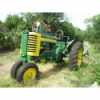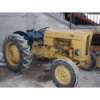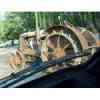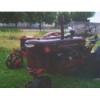The mass use of tractors in Argentina only began when those machines were locally produced in the 1950s –without the importation costs, these machines were much more affordable; plus there were local tractor versions that had been specially designed for the standard Argentinean field.
The first imported tractors were powered by steam engines. The application of these kind of engines to tractors was revolutionary for the need of a controlled use of power was very much important in these kind of locomotives. John Deere was one of the main providers to Argentina of these machines.
Soon after this invention took off, tractors suffered some alterations, such as the replacement of steam engines for diesel or kerosene ones. Some of the main international manufacturers provided the Argentine market at that time.
But it wasn’t till mid 1940s when Argentina took the autoindustry in its hands.
The folk story tells that Perón, who had established a love-hate relationship with the United States had broken up all commercial tides, and while Argentina stoped selling them some of the most important prime materials the US bought, they wouldn’t sell one manufactured item to the country. One of the most famous frases at that time was “If the US wants to paint their houses with our line oil they’ll have to bring their houses down to Argentina…”the reply of some of the most liberal sectors in our country was –regarding the importance of our importation of toilet paper manufactured in the US- “so, when we want to go to the toilette we might as well travel all the way up to the States for some toilette paper?”.
No house came to Argentina, and no one traveled that much for some toilette paper, but the impact of this closure was huge.
In 1948, Perón inaugurated the IAME –mechanical industry company owned and run by the Argentinean state- with the aim of producing tractors in the country.
A very large group of experts began took over the titanic task of creating from scraps a mechanical industry. The first move this group made was a survey on what local farmers preferred on this matter. The most voted answer was the German Lanz Bulldog, produced in Mannheim, for it had a simple motor that could be easily fixed if there was any trouble, it only needed heating before use, and this could be done using lamps powered by a kerosene pump, hence there was no need of electrical power… Plus this tractor’s motor could be worked with alternative combustibles –at that time Diesel fuels were very expensive and rare to find in the country- such as a mix of kerosene and used oil, or even regular oil and animal fat. It served it purpose in the fields and it was very cheap to maintain. And its power was enough to remove the old steam boilers for thrashing line and wheat machines.
The inspiration came from the Lanz German tractor. Many units of this machine were brought to the country and mechanics and technicians began to work on a “national model” tractor with a two time motor with only one cylinder of 55HP, that could traction a four plowshare of 14 inches.
The result was a local very cheap version christen as the Pampa. There were 3500 Pampas made in the country from 1952 to 1963.
At the same time, some other companies began to settle down in the country to locally produce tractors, for it was economically more profitable than exporting them and there was an unexploded market anxiously demanding these products. Fiat Conrad was one of the first ones to come to Argentina in 1954. Later on came John Deere in 1958. Two of the most important ones at the time, adapting many of their models to the local market as well as offering their standard ones to the Argentine market. The move was a success.
For more information: Email:
admin@frassinetti.com Bob Frassinetti.
Press here to go back to web blog:Daily Updates on Art, Antiques, Collectibles as well as travel information for Buenos Aires, Argentina. Phone me thru Skype, ID: Bob Frassinetti or you can also chat with me thru Yahoo, press here:
Yahoo Contact Find me on MySpace and be my friend!
Bob Frassinetti. Copyright 2005. Roberto Dario Frassinetti.
Case 1926 Tractor.
The History of Case Tractors in Argentina is that of the development and growth of the Latin American fields. As it's world wide known, Argentina was for a very long time the World's barn. And in this picture, tractors and growth of field productivity is the key element.
Case steam tractors are a landmark of the Argentine field, especially if we take into account the fact that this was the earliest international field company to settle in Buenos Aires and take the Argentine capital as the ground base operation center for the rest of the South American Continent.
The story began in 1842 in Rochester, Wisconsin. It was then when Jerome Increase Case started his company. He soon moved to Racine, and it was there where he began to manufacture threshers.
In 1953 Case and his partners brought into life the J.I. Case & Company, usually better known from 1865 onwards through means of its trademark:
Eagle, "Old Abe".
After these ground braking inventions and adaptations Case did not put a stop to his inventive and wit. In 1869 he built his first steam engine pulled by horses. American experts say that Old No. 1 is now on display in the Smithsonian Institution; this was wheel-mounted but still drawn by horses and used only for belt power. In 1876 their first steam traction engine was ready; and it was in 1892 when he launched the first Case farm tractor.
By 1890 the rapid and amazing growth of the Argentine fields and the increase within the demand by European countries leads the South American business to a sustained growth. Such was the fast growing rate that Case finds productive to open a branch office in Buenos Aires. As we pointed out above this was the first branch of a U.S. based company in this industry ever to be established in Argentina. Later, two more branches are opened there. And the success within the country and the region was indeed unquestionable.
Even at this early stage of the 20th century, the South American region began to increase its technical skills within the field. Argentina was the door through which these innovations entered the sub continent.
This means that Argentina was the starting point for the distribution of these tractors, and the place where the broadest variety of models could (and still can) be found.
In 1920 Case penetrates the final bastion of the Latin American region as it conquers the Brazilian market.
And by the end of the 20s Argentina would become a true laboratory for experimental models for the rest of the world. Indeed some true gems can be found here from the very early days of this tractor company.
The story of Case in Argentina kept on growing at an amazing rate even after other American and European companies began to exploit this fertile market.
Email Bob Frassinetti.
The Buenos Aires Art
Dealer,Argentina.
Bob Frassinetti. Copyright 2005. Roberto Dario Frassinetti.
More Information Photos and Links
Bob Frassinetti on eBay
Topic: Antique Tractors
Topic: Train Travel Argentina
Topic: Steam Tractors
La Trochita antique steam engine train
Case Steam and Tractor
Tractors found in Argentina
Bob Frassinetti on eBay
Topic: Antique Tractors
Topic: Train Travel Argentina
Topic: Steam Tractors
La Trochita antique steam engine train
Case Steam and Tractor
Tractors found in Argentina








